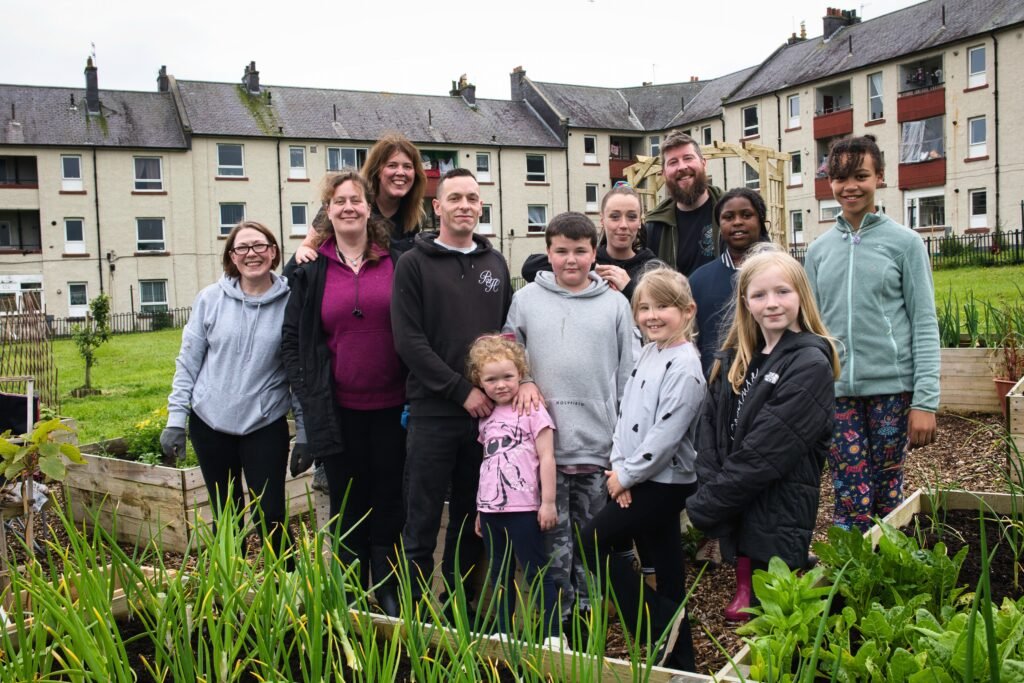Organic, quietly radical, disruptive and definitely grassroots, this is not a leisure activity; it is a powerhouse for positive change happening under our noses that we mustn’t overlook.

The social movement for collective food growing in Scotland is happening across the country in all settings and sizes, in community and market gardens, orchards, and community-supported agriculture projects. Sites are on public and private land, including local authority, churches, NHS, schools, farms, large estates, and housing developments. This movement is emerging for many reasons, and as it expands and develops, it is increasingly significant to the transformation required for a sustainable, resilient food future. It acts as a ‘plant community’: ‘early colonisers’ are connecting people together, they are drawing on and using appropriate resources, creating conditions that allow local people, place and nature to thrive. Community- led growing sites are not just growing food, they are hubs for a wide range of local food initiatives, providing sustainable solutions to food insecurity by empowering people, enabling them to participate and or benefit.
The aim is not to replace our trips to the supermarket; it is to build and deliver part of a more resilient food future for Scotland that is visible and local, where we grow more of what we eat and eat more of what we grow, with and for nature and climate. The centralised global food system that feeds us has developed rapidly in the past 60 years. It has brought us abundance, choice, and convenience, with most of our food now coming from other countries. This system is not a global success as it leaves out most of the world’s citizens, including people living in food poverty and insecurity in Scotland. We rely very heavily on it for our food, and in many ways, it is successful. It is also threatened, increasingly vulnerable to multiple crises and contributing to many of them: climate and nature emergencies, wars, depleted soil resulting in less nutrition and contributing to diseases, animal cruelty, degradation, pollution and waste.
Scotland imports, on average, 70% of the food we eat every year. Most of what is grown in our agricultural sector is for animal feed or alcohol products, and much of that is for export. 80% of Scotland’s land area is considered agricultural land; however, only 10% of this is arable, the rest for grazing and grassland. Horticulture, local market gardens and community food growing contribute unprocessed fruit, vegetables, grains and legumes required for a healthy and nutritious human diet, with some grown organically and regeneratively. This is not at the scale it could be, with challenges to scale up, including land and skills shortages and conflicting policy. There is diminishing land available from a low start, with much of the suitable land competing with multiple demands, from growing trees to sequestering carbon in years to come to new homes and substations.
There are clear opportunities to secure more land for more communities to participate and for systems to safeguard suitable land. Community groups are creative, unlocking more land for growing, securing and sharing land often overlooked or underused, and informal, often intergenerational, skills sharing. They are building food security, resilience and capacity for food response to emergencies, as many proved during COVID.
This food movement, started by communities using food for social benefits including connection, mental health and wellbeing, now has a strong focus on food production, and is the preferred way for communities to act on the climate and nature emergencies. A new stewardship role in partnership with nature has developed, providing learning through participating, with sites rewilding, planting for pollinators, using greener energy sources managing water including scarcity and flooding, providing some fresh local food year-round through sheltered growing, teaching composting and advocating for reduced waste and more, all demonstrating to their community how to make a just transition together, in a way that suits them and their resources.
There are practical ways we can expand, extend and support this movement to be transformational, and for all communities and peoples to have the opportunity to participate and/or benefit. Key are adjustments in the planning system; wider recognition, status and understanding of what is happening, what is possible, the innovative, practical solutions that are being overlooked; effective targeted investment for infrastructure and workers for what is mostly a volunteer-led movement, proven effective and high return; and partnerships that provide research, data collection and evaluation that support rapid transformational change.
This article was first published in the July edition of The Geographer.

Leave a Reply